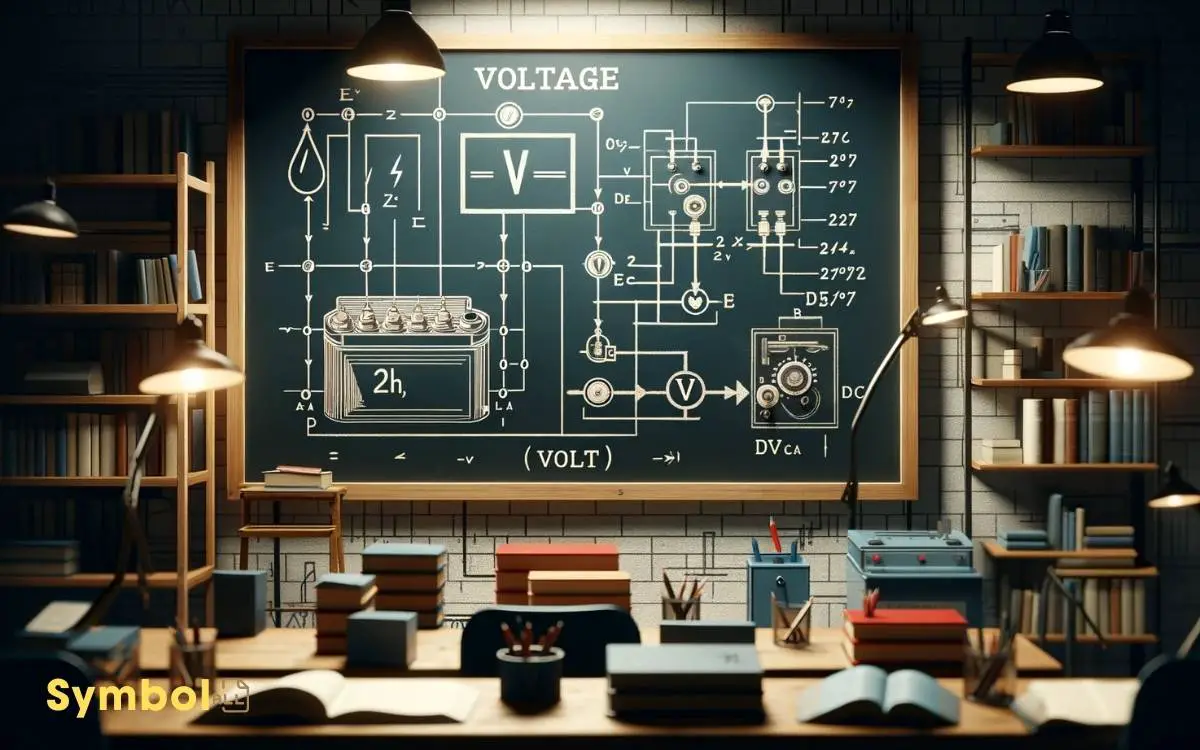Which Symbol and Unit of Measurement Are Used for Voltage?
In your quest to understand electrical schematics, you’ll frequently encounter the symbol ‘V’. This symbol represents voltage, a critical parameter in electrical engineering.
Voltage, measured in volts (V), indicates the electrical potential energy available to move electrons through a conductor. It’s the driving force behind the flow of electric current.
Recognizing the ‘V’ symbol and understanding that voltage is measured in volts allows you to grasp the dynamics of electric circuits. This knowledge is pivotal for diagnosing and troubleshooting issues within various systems.
With a solid grasp of voltage concepts, you’re on your way to uncovering deeper insights into electrical engineering.

Key Takeaways
Understanding Voltage
Voltage, fundamentally, is the electrical potential difference between two points, driving the flow of electrons through a conductor. This concept is crucial in understanding how electric circuits operate.
In essence, it’s the force that propels electrons to move, enabling the flow of electric current. You’ll find that voltage can exist without current; however, current can’t flow without voltage. This is because voltage acts as the necessary push that initiates electron movement.
It’s measured in volts (V), with various devices such as voltmeters specifically designed for this purpose. Grasping the concept of voltage is vital for analyzing and designing electrical circuits, as it directly influences the current and power within the system.
Understanding this relationship allows you to predict how electrical systems behave under different conditions.
The Symbol for Voltage
In electrical engineering and related fields, the symbol ‘V’ represents voltage, denoting the potential difference that drives electron flow through a circuit. This symbol is integral in understanding how circuits are designed and analyzed.
- *’V’ is universally recognized in schematics,* allowing engineers and technicians worldwide to communicate circuit designs efficiently.
- *It signifies the electric potential energy per unit charge,* which is fundamental in calculating the energy required to move charges through a circuit.
- *Understanding ‘V’ is crucial for diagnosing and troubleshooting electrical systems,* as it helps in pinpointing where potential drops or increases occur, which can indicate issues within the circuit.
Grasping the significance of ‘V’ empowers you to delve deeper into the nuances of electrical engineering with a solid foundation of its basic principles.
Voltage Measurement Unit
You must understand that the unit of voltage measurement is the volt (V), which quantifies the potential difference or electromotive force between two points in an electrical circuit.
The symbol ‘V’ represents this unit, aligning with the International System of Units (SI).
This foundational knowledge sets the stage for deeper exploration into the dynamics of voltage in electrical systems.
Voltage Unit Explained
Understanding the unit used to measure voltage is essential for accurately interpreting electrical systems. The unit of measurement for voltage is the volt, symbolized as ‘V’.
It quantifies the potential difference between two points in an electrical field or circuit. Essentially, voltage measures the force that drives electric current through a conductor.
- Volt (V): The standard unit of voltage, indicating the potential difference.
- Millivolt (mV): 1/1000 of a volt, used for small voltage measurements.
- Kilovolt (kV): 1000 volts, utilized in high voltage applications.
Accurately grasping the concept of volts, millivolts, and kilovolts is crucial for analyzing and working with electrical systems. This knowledge enables precise calculations and ensures the effective operation of electrical devices.
Symbol for Voltage
To accurately measure voltage in electrical systems, it’s essential to recognize that the standard symbol for this unit is ‘V’. This notation isn’t arbitrary; it signifies the measurement of electric potential or potential difference between two points in an electric circuit.
The ‘V’ symbol originates from Alessandro Volta‘s last name, the Italian physicist who invented the voltaic pile, considered the first chemical battery.
Understanding this symbol is crucial for anyone delving into electrical engineering or physics. It’s the cornerstone of analyzing and interpreting circuit diagrams.
When you encounter ‘V’ in equations or schematics, it directly pertains to voltage.
This precise, universally accepted notation ensures consistency in technical discussions and documentation across the globe, facilitating a seamless exchange of knowledge and information within the scientific community.
History of Voltage Measurement
The history of voltage measurement reflects centuries of scientific exploration and innovation, tracing back to the early experiments with electricity.
- Electrostatic Generators: In the 18th century, scientists used electrostatic generators, producing static electricity to study voltage phenomena.
- Voltaic Pile: Alessandro Volta’s invention of the voltaic pile in 1800 marked the first chemical battery, enabling more systematic voltage studies.
- Galvanometers: The development of galvanometers in the 19th century allowed for the precise measurement of voltage in electrical circuits.
These milestones laid the groundwork for modern electrical engineering, providing the tools and concepts necessary to understand and manipulate electrical energy.
Importance of Voltage in Electronics
You must understand that voltage plays a critical role in the functionality of circuits, essentially dictating the flow of current.
It’s also pivotal in ensuring devices operate efficiently, as incorrect voltage levels can lead to power wastage or device malfunction.
Thus, mastering the understanding of voltage’s role and its correct application is fundamental in electronics design and maintenance.
Voltages Role in Circuits
Understanding voltage’s pivotal role in circuits is essential, as it drives the flow of electrical current through electronic devices, enabling them to function as designed.
Voltage acts as a force that pushes electrons through a conductor, and its precise control is crucial for the operation of any electronic circuit. Without the correct voltage, components may not operate efficiently or could be damaged.
- Voltage Differential: Determines the direction and magnitude of current flow, essential for circuit functionality.
- Signal Processing: Voltage levels represent binary states in digital electronics, crucial for data processing.
- Component Specification: Devices are designed to operate at specific voltages for optimal performance; exceeding these levels can lead to failure.
Grasping the significance of voltage in circuits equips you with a fundamental understanding necessary for delving deeper into electronics.
Powering Devices Efficiently
Optimally selecting and applying voltage is crucial for powering devices efficiently, ensuring they operate at peak performance without undue energy waste or risk of damage.
You must understand that voltage, symbolized as V and measured in volts, acts as a driving force for electric current in circuits.
This precise application of voltage is foundational in electronics, dictating the performance and longevity of devices.
Too low a voltage fails to adequately power a device, while excessive voltage can lead to overheating and potential failure.
Therefore, matching the voltage requirements of a device with its power source optimizes energy consumption and minimizes risk, embodying the principle of efficiency in electronics.
This targeted approach not only conserves energy but also prolongs device lifespan, highlighting voltage’s pivotal role in effective power management.
How to Read Voltage Symbols
Interpreting voltage symbols requires familiarity with the standardized notations and abbreviations used in electrical engineering.
When you encounter voltage in schematics or documentation, you’re likely to see specific symbols and abbreviations that convey essential information about the electrical potential difference.
- V: The most common symbol for voltage, indicating electric potential or potential difference measured in volts.
- E: Sometimes used instead of V, especially in equations, representing electromotive force (EMF) in volts.
- U: Less common, but used in certain contexts, particularly in Europe, to denote voltage.
Understanding these symbols allows you to grasp the voltage levels involved in electrical circuits accurately. Each symbol serves as a concise representation of voltage, critical for analyzing and designing electrical systems.
Comparing Voltage Units
Having familiarized yourself with the symbols representing voltage, let’s now explore how different units of voltage compare to each other in terms of measurement and application.
| Unit | Application |
|---|---|
| Volt (V) | The standard unit of measurement for voltage, used in most electrical devices. |
| Millivolt (mV) | One thousandth of a volt, commonly used in small-scale electronics and signal processing. |
| Kilovolt (kV) | One thousand volts, applicable in high-voltage power transmission and electrical grids. |
Understanding these units allows you to gauge the magnitude of voltage in various contexts precisely. It’s crucial to select the appropriate unit when measuring or discussing voltage, as each serves distinct sectors within the electrical and electronic fields.
This specificity ensures accurate communication and application of voltage in technical environments.
Common Misconceptions About Voltage
You might often confuse voltage with current, yet understanding their distinct roles is crucial for grasping electrical concepts.
Misinterpreting voltage levels can lead to incorrect conclusions about a circuit’s functionality or safety.
Let’s clarify these misconceptions to ensure your foundational knowledge of voltage is accurate and comprehensive.
Voltage Vs. Current Confusion
Many people often confuse voltage with current, not realizing that they represent fundamentally different electrical quantities. This confusion stems from a lack of understanding about the distinct roles each plays in an electrical circuit.
- Voltage is the electrical potential difference between two points. It’s analogous to the pressure that pushes electrical charges through a conductor.
- Current, on the other hand, is the flow rate of electric charge. It’s akin to the volume of water flowing through a pipe per unit of time.
- Interdependency: While related, voltage and current aren’t interchangeable. Voltage can exist without current, but current requires a voltage to initiate the flow of electric charge.
Grasping these differences is crucial for anyone looking to deepen their understanding of electrical principles.
Misinterpreting Voltage Levels
Understanding the differences between voltage and current sets the stage for exploring common misconceptions about voltage levels.
You might confuse voltage’s role, thinking it’s a direct measure of power. However, voltage is the electrical potential difference, crucial for driving current but not power itself.
Misinterpreting high voltage as inherently dangerous overlooks current’s role in electrical hazards. It’s the current, after a certain threshold, that poses a risk to human safety, not voltage alone.
Similarly, equating low voltage with safety can mislead. Even low-voltage systems can deliver harmful currents under specific conditions.
It’s essential to grasp that voltage levels, while indicative of potential energy, don’t singularly determine electrical safety or power. Analyzing both voltage and current provides a comprehensive understanding of electrical systems’ potential risks and capabilities.
Voltage in Electrical Circuits
In electrical circuits, voltage acts as the driving force that propels electrons through conductors, enabling the flow of electric current. This fundamental concept is essential for you to grasp the dynamics of how electrical devices function.
Understanding voltage within circuits allows for the design and analysis of these systems with precision.
- Potential Difference: Voltage represents the potential difference between two points in a circuit, crucial for calculating energy transfer.
- Ohm’s Law Application: Utilizing voltage, along with resistance, determines the current flow, as dictated by Ohm’s Law \(V = IR\).
- Energy Source Identification: Identifying voltage sources, whether batteries or generators, is pivotal in understanding circuit functionality and the distribution of power.
This intricate interplay between voltage, current, and resistance is foundational in the realm of electronics and electrical engineering.
Measuring Voltage: Tools and Techniques
To accurately measure voltage, you’ll need to familiarize yourself with various measurement tools and the techniques that optimize their use.
Multimeters and oscilloscopes are primary instruments, each offering distinct advantages depending on your specific measurement requirements.
Understanding their operational principles and application nuances is crucial for precise voltage analysis in any electrical circuit.
Voltage Measurement Tools
Accurately measuring voltage requires a variety of specialized tools and techniques tailored to the specific needs of the task.
For precision and efficiency, you’ll need to familiarize yourself with the following essential instruments:
- Multimeter: A versatile device capable of measuring voltage, current, and resistance. Digital multimeters (DMMs) offer high accuracy and can handle a wide range of voltages.
- Oscilloscope: For observing the detailed time-varying voltages, an oscilloscope provides a visual representation, crucial for analyzing the behavior of electrical signals in circuits.
- Voltage Probe: Specifically designed to connect with DMMs or oscilloscopes, these probes safely extend the range and capabilities of your measurement tools, enabling accurate voltage readings across various environments.
Each of these tools plays a pivotal role in ensuring precise voltage measurements, critical for diagnosing issues and ensuring the proper functioning of electronic circuits.
Techniques for Voltage Measurement
Mastering the techniques for voltage measurement often involves employing a range of tools, each selected for its precision and suitability to the task at hand.
You’ll primarily use a multimeter, set to the voltage function, to accurately gauge voltage across components.
It’s crucial to select AC or DC on the multimeter based on the circuit you’re testing. For precision tasks, an oscilloscope might be preferable, offering detailed voltage waveform visualization over time.
Connecting probes correctly is paramount; incorrect placement can lead to inaccurate readings or damage.
Voltage Symbols in Schematics
Understanding voltage symbols in schematics is crucial for interpreting electrical diagrams accurately. These symbols represent the presence and characteristics of voltage within a circuit, serving as the foundational language for electrical engineers and technicians.
To aid your comprehension, consider these key symbols:
- V or U: Denotes voltage at a point in the circuit. It’s universally recognized across schematics, indicating potential difference.
- ⏚: Represents an earth ground, crucial for safety and the reference point for measuring voltage.
- ⏛: Symbolizes a chassis ground, essential for understanding the return path for current in devices.
Mastering these symbols enhances your ability to navigate and analyze complex electrical schematics effectively, laying the groundwork for advanced electrical troubleshooting and design.
Application of Voltage in Daily Life
Voltage plays a critical role in powering your everyday devices, from smartphones to refrigerators, by converting electrical energy into usable forms. It’s essential to understand how voltage underpins the functionality of various appliances and systems you rely on daily.
The table below illustrates typical applications of voltage in household items, showcasing the diversity of electrical energy utilization.
| Device | Typical Voltage (V) | Application |
|---|---|---|
| Smartphone | 3.7 – 5 | Charging and operation |
| Refrigerator | 110 – 220 | Cooling mechanism |
| LED Light Bulb | 2.8 – 3.3 | Illumination |
| Laptop | 11 – 20 | Charging and operation |
This selection underscores the adaptability of voltage to various power needs, ensuring devices operate efficiently and effectively. Understanding these applications allows you to appreciate the engineering precision behind everyday conveniences.
Safety Tips for Handling Voltage
Why should you be cautious when handling voltage in everyday devices? Voltage, being the potential difference that drives current through a conductor, poses inherent risks, particularly when mismanaged or misunderstood.
Safety should be your paramount concern to mitigate the dangers of electrical shock, equipment damage, or fire hazards.
Consider these essential safety tips:
- Always disconnect power sources before servicing or inspecting electrical equipment. This precaution prevents accidental electrocution.
- Use insulated tools and wear protective gear. These measures provide a barrier against electrical currents, reducing the risk of shock.
- Follow manufacturer guidelines and electrical codes. Adherence to these instructions ensures that devices operate within safe parameters, minimizing the likelihood of malfunction or hazardous incidents.
Understanding and implementing these precautions can significantly enhance your safety when dealing with voltage.
Enhancing Your Voltage Knowledge
To deepen your grasp of electrical concepts, it’s crucial to explore the fundamentals of voltage, including its symbols and units.
Voltage, represented by the symbol ‘V’ and measured in volts (V), serves as a cornerstone in understanding electrical circuits. It’s the driving force that propels electrons through conductors, enabling the flow of electric current.
Grasping this concept isn’t just academic; it’s practical, influencing how you interpret circuit diagrams, troubleshoot electrical issues, and apply safety measures.
Each volt denotes the potential difference required to drive one ampere of current against one ohm of resistance. Delving into these relationships equips you with the analytical skills to solve complex electrical problems, enhancing your expertise beyond the basics.
Conclusion
Understanding voltage, symbolized by ‘V’ and measured in volts, is crucial for navigating the complexities of electronics.
Remarkably, the highest voltage ever recorded was 1.53 billion volts during a lightning strike, showcasing nature’s immense electrical power.
Familiarizing yourself with voltage’s role and safety measures is essential for both practical applications and advancing technological innovation.
By delving into voltage’s principles and applications, you’re equipping yourself with knowledge pivotal for both everyday life and scientific exploration.






